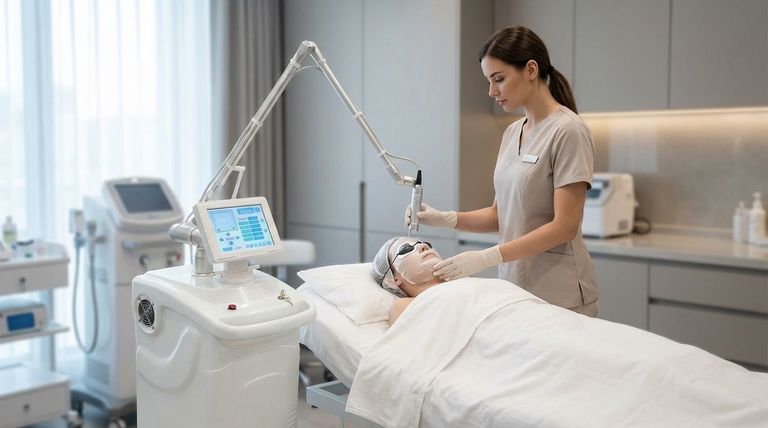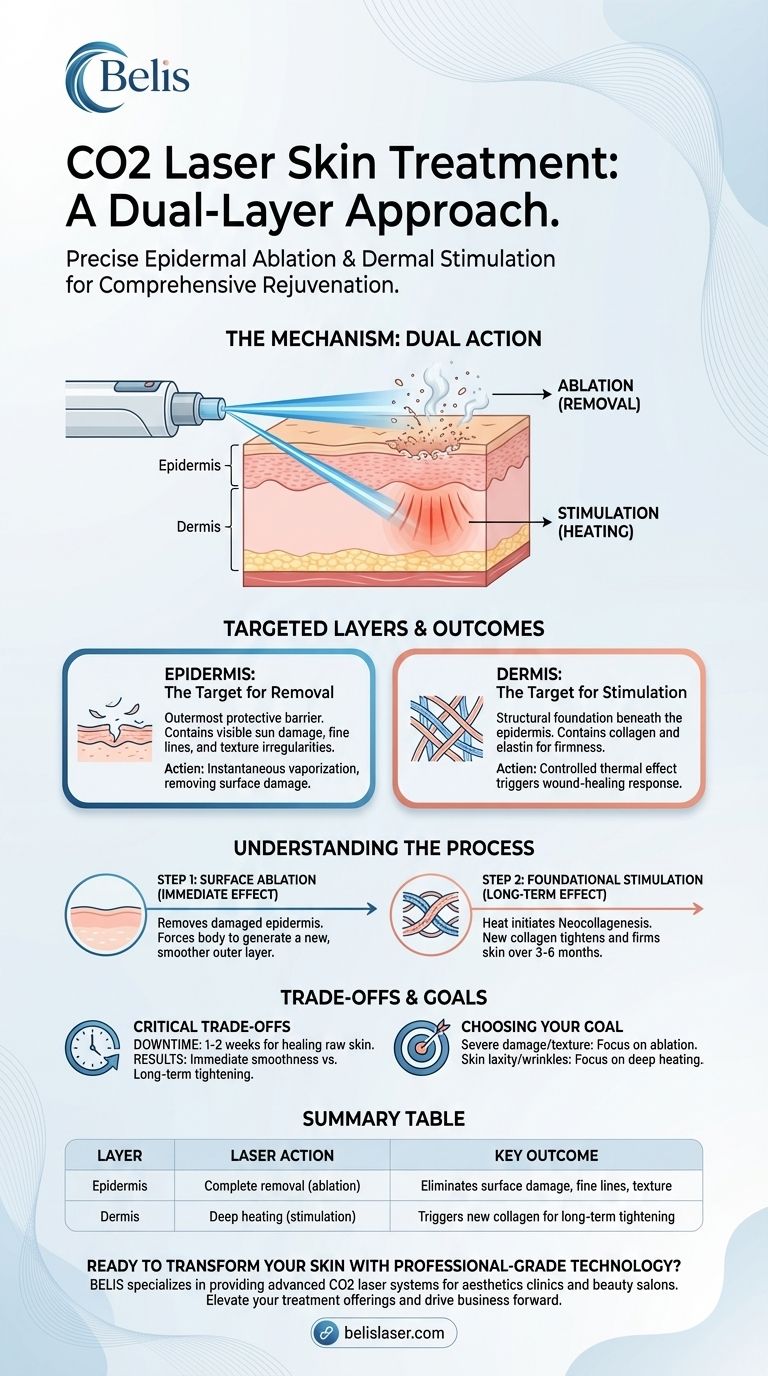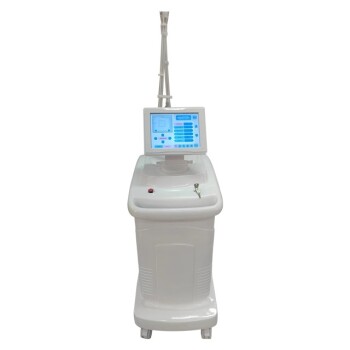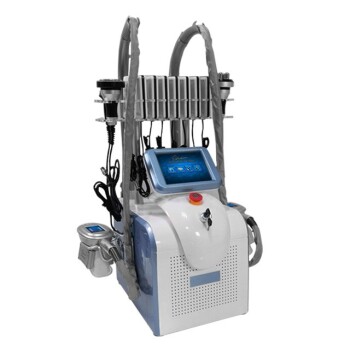A CO2 laser treatment is designed to precisely remove the entire outer layer of your skin. This process, known as ablation, vaporizes the epidermis to eliminate surface imperfections while the laser's energy simultaneously penetrates deeper to heat the underlying dermis, triggering a powerful regenerative response.
The true mechanism of a CO2 laser is its dual action: it removes the damaged, superficial skin you can see (the epidermis) while stimulating the foundational layer you can't see (the dermis) to rebuild new collagen for lasting structural improvement.

The Two Layers Targeted by the Laser
To understand the laser's effect, you must first understand its targets. The skin is composed of two primary layers relevant to this treatment, and the CO2 laser interacts with each one differently.
The Epidermis: The Target for Removal
The epidermis is the outermost layer of your skin. It acts as a protective barrier and is where most visible signs of sun damage, fine lines, and textural irregularities reside.
A CO2 laser uses a highly focused beam of light that is absorbed by the water within skin cells. This causes the instantaneous vaporization of the epidermis, physically removing it layer by layer in a controlled manner.
The Dermis: The Target for Stimulation
Beneath the epidermis lies the dermis. This deeper, thicker layer is the skin's structural foundation, containing the collagen and elastin fibers that provide strength, firmness, and elasticity.
The CO2 laser does not remove the dermis. Instead, the heat from the laser energy radiates down into this layer, creating a controlled thermal effect.
Understanding the Dual-Action Mechanism
The effectiveness of CO2 laser resurfacing comes from performing two distinct jobs in a single treatment.
Step 1: Ablation of the Surface
By removing the entire epidermis, the treatment immediately eliminates a significant amount of visible damage. This ablation forces the body to generate a completely new, smoother, and more even-toned outer layer of skin.
Step 2: Stimulation of the Foundation
The heat delivered to the dermis is interpreted by the body as a controlled injury. This initiates a profound wound-healing response.
The primary result of this response is neocollagenesis, the creation of new, organized collagen fibers. This process unfolds over the months following the treatment, gradually tightening and firming the skin from within.
The Critical Trade-offs of an Ablative Laser
This powerful, dual-action approach involves significant considerations. Understanding the trade-offs is essential for managing expectations.
The Necessity of Downtime
Removing the entire epidermal layer leaves the skin raw and vulnerable. The body needs time to regrow this protective barrier.
This healing process is the reason for the significant downtime associated with CO2 laser treatments, which often involves redness, swelling, and peeling for one to two weeks.
Immediate vs. Long-Term Results
The initial smoothness you see after healing is a direct result of epidermal removal. However, the most significant and lasting results—such as skin tightening and reduction of deep wrinkles—come from the dermal collagen remodeling.
This deeper benefit is not immediate. It takes three to six months for new collagen to fully mature, meaning the skin's appearance will continue to improve long after the initial recovery period is over.
Making the Right Choice for Your Goal
The CO2 laser's mechanism is uniquely suited for comprehensive rejuvenation.
- If your primary focus is severe sun damage or texture: The complete removal of the epidermis is the most effective way to address widespread, superficial concerns in a single session.
- If your primary focus is skin laxity or deep wrinkles: The deep heating of the dermis is critical, as stimulating new collagen is the only way to rebuild the skin's underlying support structure.
Understanding this two-layer process empowers you to see CO2 treatment not as a simple surface peel, but as a fundamental regeneration of your skin's health and structure.
Summary Table:
| Layer | Laser Action | Key Outcome |
|---|---|---|
| Epidermis | Complete removal (ablation) | Eliminates surface damage, fine lines, and texture |
| Dermis | Deep heating (stimulation) | Triggers new collagen production for long-term tightening |
Ready to transform your skin with professional-grade technology?
BELIS specializes in providing medical aesthetics clinics and premium beauty salons with advanced, reliable CO2 laser systems. Our equipment is engineered to deliver the precise ablation and controlled thermal stimulation detailed in this article, ensuring optimal patient outcomes and practice growth.
Contact our experts today to discover how BELIS can elevate your treatment offerings and drive your business forward.
Visual Guide

Related Products
- Fractional CO2 Laser Machine for Skin Treatment
- Pico Picosecond Laser Machine for Tattoo Removal Picosure Pico Laser
- EMSlim RG Laser Body Sculpting and Slimming Machine
- Clinic Use IPL SHR ND YAG Laser Hair Removal RF Skin Tightening Machine
- Cryolipolysis Fat Freezing Cavitation Lipo Laser Machine
People Also Ask
- Why am I not seeing results after a CO2 laser? Your Patience is the Key to Long-Term Skin Rejuvenation
- What will my face look like after a CO2 laser? Your Complete Recovery Timeline
- What is the downside of a CO2 laser? Weighing Dramatic Results Against Downtime & Risks
- How often should you do fractional CO2 laser? The 4-6 Week Rule for Optimal Results
- What is a fractional CO2 laser machine used for? A Guide to Advanced Skin Resurfacing



















